Lithium-Ion UPS Time: Fire Hazard or a Safe Step into the Future?
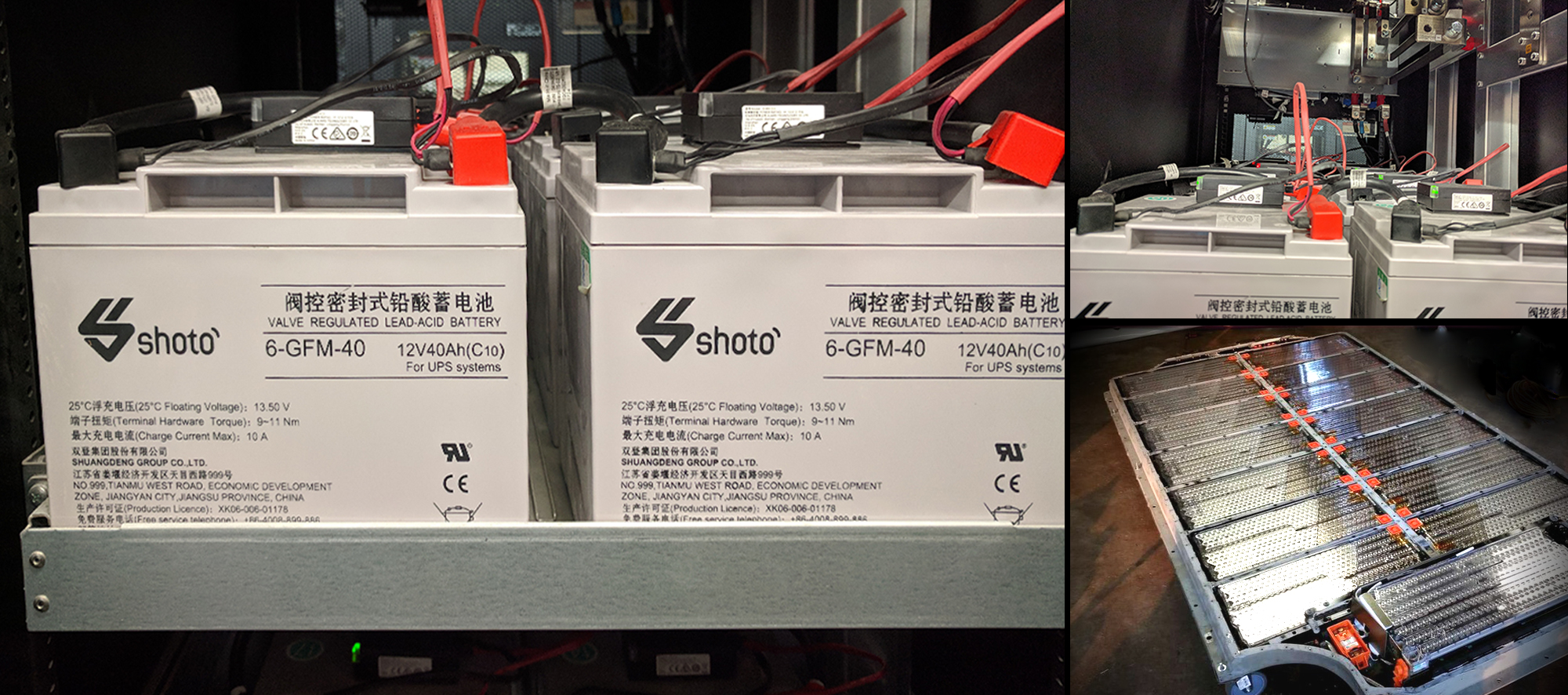
Hello, friends!
After the publication of the article “UPS and battery array: where to put? Yes, wait. ”There were a lot of comments about the dangers of Li-Ion server and data center solutions. Therefore, today we will try to figure out what is the difference between industrial solutions for lithium for UPSs from batteries in your gadget, how the battery life conditions in the server are different, why a Li-Ion battery lasts no more than 2-3 years, and in the data center this figure will increase to 10 years or more. Why the risks of lithium fire in the data center / server are minimal.
')
Yes, accidents on UPS batteries are possible regardless of the type of energy storage, but the myth of the “fire hazard” of industrial solutions on lithium is not true.
After all, many have seen the video with the ignition of the phone with a lithium battery in a car moving on the highway? So, let's see, let's figure it out, compare ...
Here we see a typical case of uncontrolled self-heating, thermal acceleration of the phone battery, which led to such an incident. You say: HERE! This is just a phone, in the server it is only crazy!
I am sure, having studied this material, the reader will change his point of view on this issue.
Current situation in the data center market
It's no secret that building a data center is a long-term investment. The price of engineering equipment only may be 50% of the cost of all capital costs. The payback horizon is about 10-15 years. Naturally, there is a desire to reduce the total cost of ownership throughout the life cycle of the data center, and in the meantime also compact engineering equipment, freeing up the area for the payload.
The optimal solution is an industrial UPS of a new iteration based on Li-Ion batteries, which have long since got rid of “childhood diseases” in the form of fire hazard, incorrect charge-discharge algorithms, have acquired a lot of protective mechanisms.
With the increase in computing and network equipment, the demand for UPS is growing. At the same time, the requirements for battery life from batteries in case of problems with centralized power supply and / or failures when starting a backup power source in the event of the use of a diesel generator set increase.
The main reasons, in our opinion, are two:
- The rapid growth of processed and transmitted information
For example, the new passenger plane Boeing
787 Dreamliner for one flight generates more than 500 gigabytes of information that
need to save and process. - Growth dynamics of the consumption of electrical energy. Despite the general trend of reducing energy consumption of IT equipment, reducing the specific energy consumption of electronic components.

In addition to clouds, growth points among the players include the development of data center-capacities in the regions: they are the only segment where there is a reserve for business development. According to IKS-Consulting, in 2016 the regions accounted for only 10% of all resources on the market, while the capital and the Moscow region occupied 73% of the market, and St. Petersburg and the Leningrad region - 17%. In the regions, there continues to be a shortage of resources for data centers with a high degree of fault tolerance.
By 2025, according to forecasts, the total amount of data in the world will increase by 10 times compared with 2016.

Still, how safe is lithium for a server or data center UPS?
Disadvantage: high cost of Li-Ion solutions.
 The price of lithium-ion batteries still remains high compared to standard solutions. SE estimates that the initial costs for powerful UPSs over 100 kVA for Li-Ion solutions will be 1.5 times higher, but in the end, the savings in ownership will be 30-50%. If you make comparisons with the military-industrial complex of other countries, then here's the news about the commissioning of a Japanese submarine with Li-Ion batteries. Quite often, lithium-iron-phosphate batteries (in the photo-LFP) are used in such solutions due to their relative cheapness and greater safety.
The price of lithium-ion batteries still remains high compared to standard solutions. SE estimates that the initial costs for powerful UPSs over 100 kVA for Li-Ion solutions will be 1.5 times higher, but in the end, the savings in ownership will be 30-50%. If you make comparisons with the military-industrial complex of other countries, then here's the news about the commissioning of a Japanese submarine with Li-Ion batteries. Quite often, lithium-iron-phosphate batteries (in the photo-LFP) are used in such solutions due to their relative cheapness and greater safety.And what about the Japanese? They remembered too late that the “relief of the boat” by 700 tons entails a change in its seaworthiness, stability ... Probably they had to add weapons on board in order to return the design values of the boat's weight distribution.
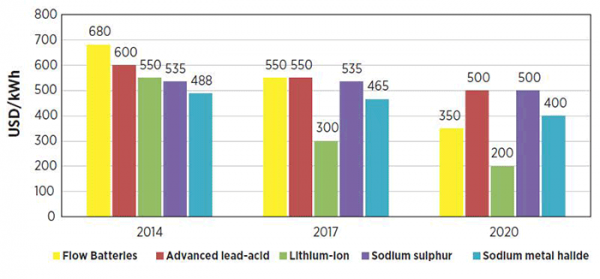
Lithium-ion batteries also weigh less than lead-acid batteries, so the Soryu-type submarine project had to be slightly reworked to maintain ballasting and stability.
In Japan, two types of lithium-ion rechargeable batteries have been created and brought to operational status: lithium-nickel-cobalt-aluminum-oxide (NCA) manufactured by GS Yuasa and lithium-titanate (LTO) manufactured by Toshiba. The Japanese fleet will use batteries like the NCA, while, according to Kobayashi, Australia for use on submarines based on the Soryu type in a recent tender were proposed batteries like LTO.
Knowing the reverent attitude to safety in the country of the Rising Sun, it can be assumed that the safety issues of lithium have been solved, tested and certified.
Risk: fire hazard.
Here we look at the purpose of publication, since opinions about the security of these solutions exist diametrically opposed. But this is all the lyrics, and what about our specific industrial solutions?
We have already considered security issues in our article , but once again we will dwell on this issue. Refer to the figure, where the protection level of the module and cell LMO / NMC battery manufactured by Samsung SDI and used in the Schneider Electric UPS was considered.
Chemical processes were discussed in the article by LadyN How lithium-ion batteries explode . Let's try to understand the possible risks in our particular case and compare them with the multi-level protection in the Samsung SDI cells, which are part of the finished Type G Li-Ion rack as part of an integrated solution based on the Galaxy VM.
Let us begin with the general case of a flow chart of the risks and causes of ignition of a lithium-ion cell.
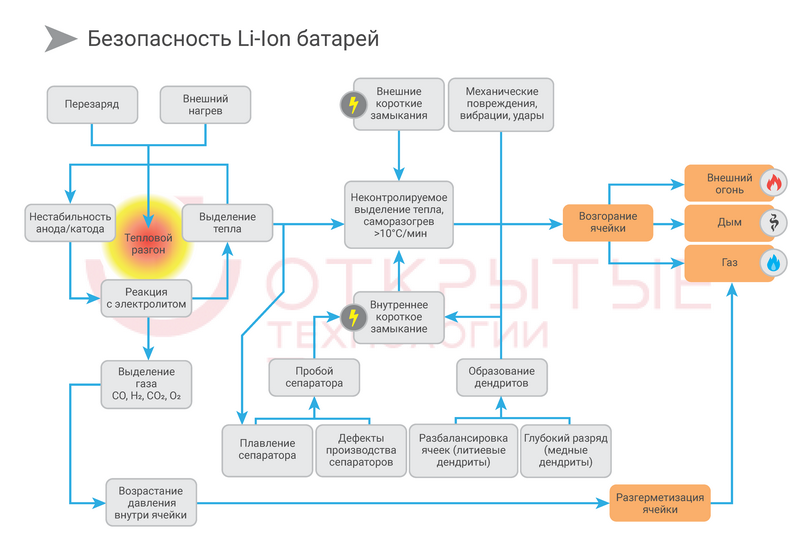
And bigger? The photo is clickable.
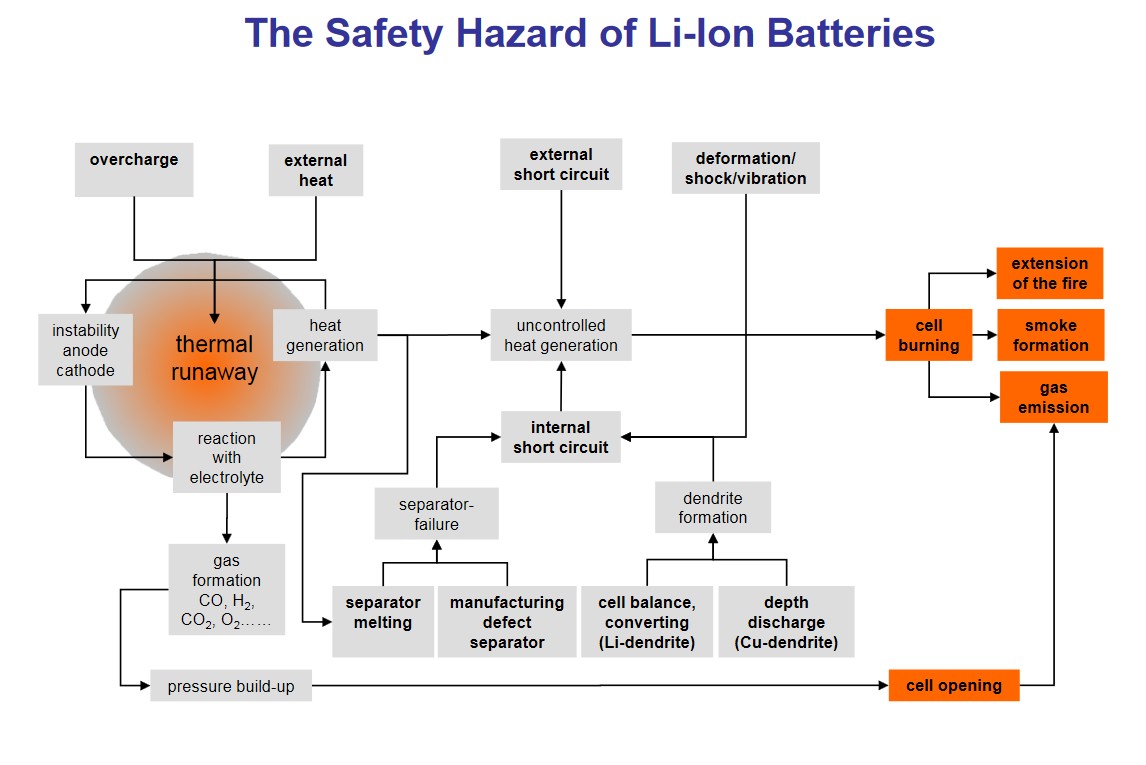
Since, depending on the chemical structure of the lithium-ion cell, there are differences in the characteristics of the thermal acceleration of the cell, here we will focus on the process described in the article in the lithium-nickel-cobalt-aluminum cell (based on LiNiCoAIO2) or NCA.
The process of development of an accident in a cell can be divided into three stages:

- stage 1 (Onset). The normal operation of the cell when the temperature gradient does not exceed 0.2 gr. per minute, and the temperature of the cell itself does not exceed 130-200 gr. depending on the chemical structure of the cell;
- stage 2, warming up (Acceleration). At this stage, the temperature rises, the temperature increase gradient rapidly increases, and there is an active release of thermal energy. In general, this process is accompanied by the release of gases. Excessive gassing must be compensated by the operation of the safety valve;
- stage 3, thermal acceleration (Runaway). Heating the battery over 180-200 degrees. In this case, the cathode material reacts to disproportionation and releases oxygen. This is the level of thermal acceleration, as in this case there may be a mixture of combustible gases with oxygen, which will cause spontaneous combustion. However, this process in some cases can be controlled, read that when the regime of external factors changes, thermal overclocking in some cases stops without fatal consequences for the surrounding space. The operability and performance of the lithium cell itself after these events are not considered.
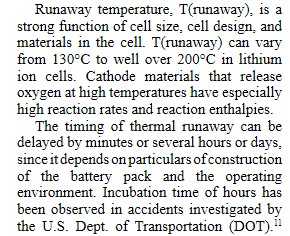

The temperature of thermal acceleration depends on the size of the cell, the structure of the cell and the material. The temperature of thermal acceleration can vary from 130 to 200 degrees Celsius. The heat acceleration time can be different and can be minutes, hours or even days ...
And what about LMO / NMC cells in lithium-ion UPSs?

And bigger? The photo is clickable.
- To prevent the anode from contacting the electrolyte, a ceramic layer is used in the cell (SFL). Blocking the movement of lithium ions occurs at 130 ° C.
- In addition to the protective vent valve, an overcharge protection system (Over Charge Device, OSD) is used, which is paired with an internal fuse and turns off the damaged cell, preventing the process of thermal acceleration from reaching dangerous values. Moreover, the operation of the internal OSD system will be earlier when the pressure reaches 3.5 kgf / cm2, that is, half as much as the opening pressure of the protective valve of the cell.
By the way, the cell fuse will operate at currents above 2500 A in a time not exceeding 2 seconds. Suppose a temperature gradient has reached a reading of 10 gr.C / min. In 10 seconds, the cell will have time to add about 1.7 degrees to its temperature, being in overclocking mode.
- A three-layer separator in the cell in the overcharge mode will block the transition of lithium ions to the anode of the cell. The blocking temperature is 250 gr.S.
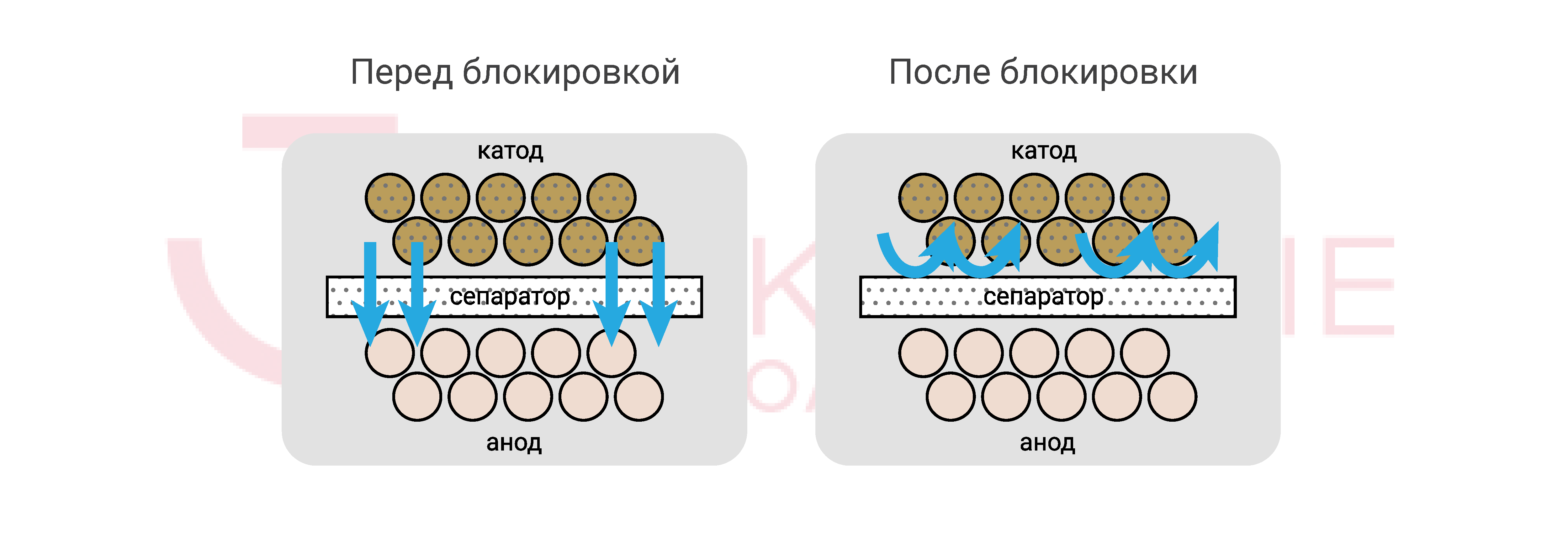
Now let's see what we have with the temperature of the cell; let's compare at what stages the different types of protection at the cell level are triggered.
- OSD system - 3.5 + -0.1 kgf / cm2 <= external pressure
Additional protection against overcurrents.
- safety valve 7.0 + -1.0 kgf / cm2 <= external pressure
- fuse inside the cell for 2 seconds at 2500 (over current overload current mode)
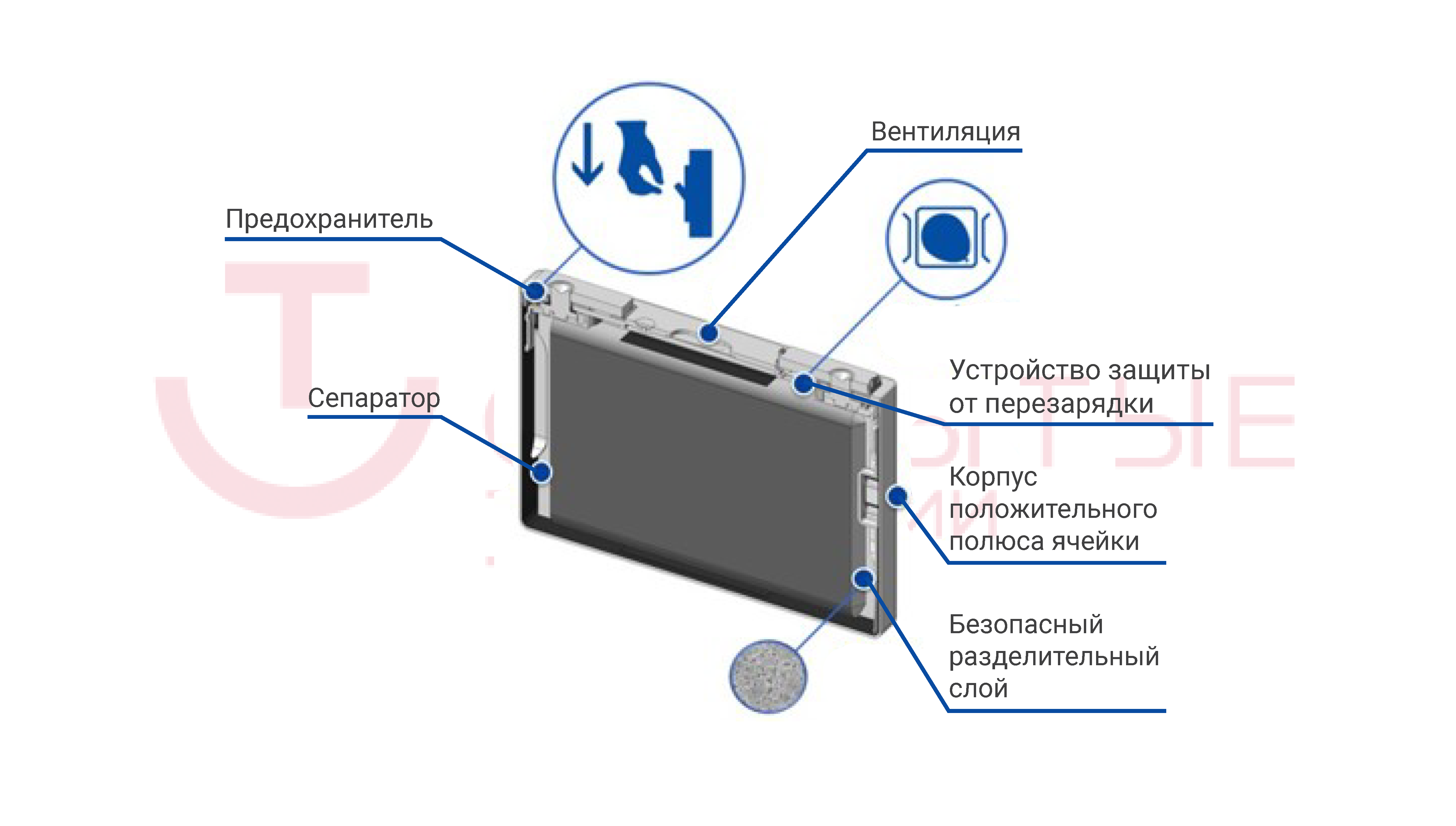

The degree of battery charge is measured in percent and shows how much of the total charge is still stored in the battery. In this case, we are considering a battery overcharge mode. It can be concluded that, depending on the chemical composition of the lithium cell, the battery may behave differently when overcharged and have different tendencies to thermal acceleration. This is due to the different specific capacity (A * h / g) of various types of Li-Ion cells. The greater the specific capacity of the cell, the more rapid the heat release during recharging will be.
In addition, at 100% SOC, an external short circuit often leads to thermal acceleration of the cell. On the other hand, when the cell has a charge level of 80% SOC, the maximum temperature of the onset of the thermal acceleration of the cell shifts upward. The cell becomes more resistant to emergency modes.
And finally, for 70% SOC, external short circuits may not be the cause of thermal acceleration at all. That is, the risk of cell ignition is significantly reduced, and the most likely scenario is only the triggering of a lithium battery safety valve.
In addition, it can be concluded from the table that the LFP (purple curve) of the battery usually has a steep slope of temperature rise, that is, the “warm-up” stage gradually passes into the “thermal overclocking” stage, and the system’s resistance to overcharging is somewhat worse. Batteries such as LMO, as we can see, have a smoother warm-up characteristic when recharging.
IMPORTANT: when the OSD system is triggered, the cell is reset to the bypass. Thus, the voltage on the rack decreases, but it remains in operation and generates a signal to the UPS monitoring system through the BMS system of the rack itself. In the case of a classic UPS system with VRLA batteries, a short circuit or an open circuit inside a single battery in a string can lead to the failure of the UPS as a whole and the loss of efficiency of the IT equipment.
Based on the above, for the case of using lithium solutions in the UPS, the risks remain relevant:
- Thermal acceleration of the cell, module as a result of external short circuit - several levels of protection.
- Thermal acceleration of the cell, module as a result of internal battery failure - several levels of protection at the cell level, module.
- Recharge - protection by means of BMS plus all levels of protection of the rack, module, cell.
- Mechanical damage is irrelevant in our case, the risk of an event is negligible.
- Overheating of the rack and all batteries (modules, cells). Uncritically up to 70-90 degrees. If the temperature in the UPS installation room rises above these values, it means that this is already a fire in the building. In normal data center operation modes, the event risk is negligible.
- Reduction of battery life at elevated room temperatures - continuous operation at temperatures up to 40 degrees is allowed without a noticeable decrease in battery life. Lead batteries are very sensitive to any temperature increase and reduce their residual life in proportion to the temperature increase.
Let's look at the block diagram of the risk of accidents with lithium-ion batteries in our case of use in the data center server. We simplify the scheme a bit, because lithium UPSs will be used in ideal conditions, if you compare the battery conditions in your gadget, phone.

The photo is clickable.
CONCLUSION: Specialized lithium batteries for UPS data center, server have a sufficient level of protection from abnormal situations, and in a comprehensive solution a large number of different protection levels and more than five years of operating experience of these solutions suggest a high level of security of new technologies. In addition, we should not forget that the operation of lithium batteries in our sector looks like “greenhouse” conditions for Li-Ion technologies: unlike your smartphone in your pocket, no one in the data center will drop the battery, overheat, discharge every day, actively use in buffer mode.
You can learn more details and discuss a specific solution using lithium-ion batteries for your server or data center by sending a request to info@ot.ru , or by making a request on the company's website www.ot.ru.
OPEN TECHNOLOGIES - reliable integrated solutions from world leaders, adapted specifically to your goals and objectives.
Author: Oleg Kulikov
Lead Design Engineer
Department of integration solutions
Company Open Technologies
Source: https://habr.com/ru/post/429264/
All Articles